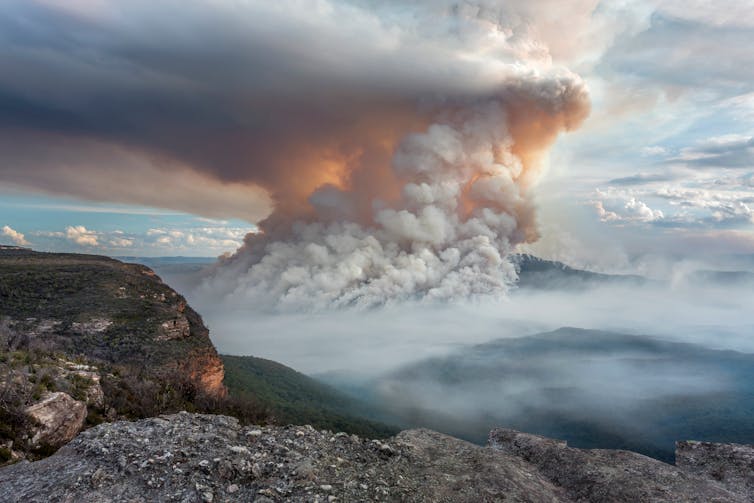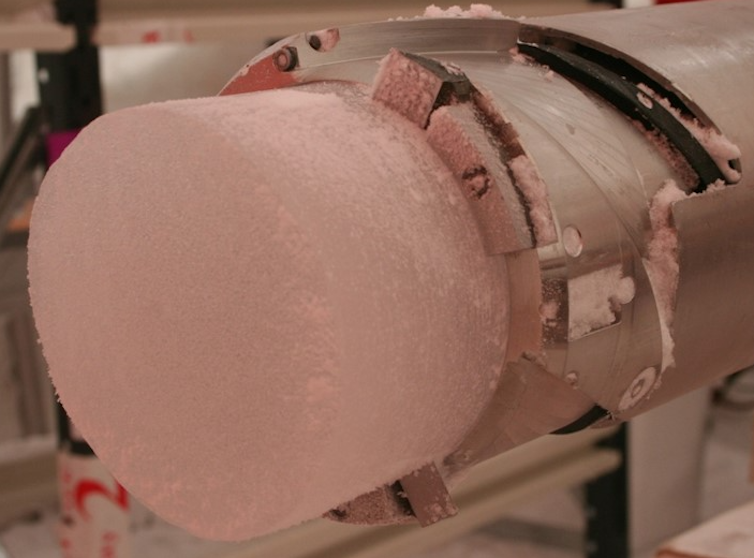Australia has a long history of bushfires. The 2019-2020 Black Summer was the worst in recorded history. But was that the worst it could get?
Our new research has reconstructed the past 2,000 years of southeast Australia’s bushfire weather, drawing on evidence of past climates laid down in changing patterns in deep ice in East Antarctica. The high and low pressure weather systems south of Australia are so large they connect the two continents, even though they are more than 3,000 km apart.
These historic weather patterns are recorded in the ice. Not with ash which might first come to mind, but in sea-salt spray from the Southern Ocean. When southeast Australia experiences extreme bushfire weather over summer, there is less wind around Antarctica, which means less sea-salt spray is laid down at the ice core site.
Buried in the ice is a warning. At least seven times over the last two millennia, our new research shows bushfire-prone southeast Australia has endured bushfire weather as bad or worse than what was experienced during the devastating Black Summer bushfires. The Black Summer bushfires burned through about 1.5 million hectares, or more than six times the size of the Australian Capital Territory.
This means natural climate variability can toss up more severe bushfire weather than we have yet seen. Given human-caused climate change is also loading the dice for worse and worse bushfire weather, it suggests we are underestimating how bad bushfires can be in Australia.

What makes bushfire weather?
If the weekend is forecast to be hot, dry and windy, we would say this is bushfire weather. Bushfire weather does not mean bushfires are inevitable, only they are more likely to start and more likely to be intense and fast-spreading once they ignite.
Australia’s Black Summer was caused by several climate factors combining. We had a multi-year drought, which coincided with climate variability bringing strong and hot northwesterly winds, and all against a backdrop of increasing heat and falling humidity over land brought by climate change.
Climate change is bringing more frequent and more severe bushfire weather. This trend is projected to continue into the future.
But quantifying the impacts of climate change on bushfire weather over the southeast Australian regions hardest hit by the Black Summer bushfires is difficult. This is because the climate in these mostly coastal or alpine regions varies a lot and we only have a relatively short record of observations.
Read more: Antarctic ice shows Australia's drought and flood risk is worse than thought
Our previous research on droughts – a key ingredient for extreme bushfire seasons – showed our roughly 120 years of rainfall observations does not fully cover the range of drought conditions which have occurred in the past 1,000 years. This is supported by recent palaeoclimate work reconstructing 2,000 years of eastern Australian climate variability and research using climate models to show evidence of megadroughts lasting 20 years or more in southeastern Australia.
Australia’s bushfire weather observations only extend back to 1950. In short, this means we have limited insights based on observations alone into how bad bushfire weather can be.
Answers in the ice
To reach back further in time, we looked to Antarctica. This is because Australia and Antarctica are linked through a “weather bridge”, meaning the enormous, powerful weather systems of the Southern Ocean affect both at the same time.
Year after year, these systems lift and carry different amounts of sea salt from the ocean surface and transport it to Antarctica, where it is laid down in layers of snow and ice.

About 125 km from Casey Station in Australia’s Antarctic territory lies Law Dome. This small, coastal ice cap is very useful for climate scientists, because it is regularly hit by cold cyclones from the Southern Ocean. These intense winds bring sea salt and trigger high snow accumulation – about 1.5 metres a year.
Drilling ice cores from places such as Law Dome has given us rich data sets of past climatic events. We have used these changing levels of sea salt in the ice to reconstruct rainfall and drought over two millennia in eastern Australia. Our new research focuses on Australia’s bushfire weather.
What did we find?
Using this evidence, we found an important relationship between the ice core record and the Forest Fire Danger Index, used by authorities to measure bushfire weather.
We then grouped similar weather patterns together over time, so we could get what we were really after: the connection between high and low pressure systems in the Southern Ocean, sea salt, and bushfire weather.
In the observational record, most of Australia’s bushfire disasters have been linked to intense summer cold fronts, including Ash Wednesday (1983), the Canberra bushfires (2003), Black Saturday (2009) and the Black Summer. These cold fronts direct hot, dry and intense winds from the Australian desert to the coast. This increases the chance of bushfires starting and can turn bushfires already burning into enormous conflagrations.
Using our ice core and weather datasets, we found the same weather conditions are behind periods of lower levels of sea salt in the ice and elevated bushfire weather in southeast Australia. These conditions are when the strong westerly winds circling Antarctica move north towards Australia, bringing summer cold fronts. In technical terms, this is when the Southern Annular Mode is negative.
In the last 2,000 years, we found seven years where bushfire weather was the same or even worse than the 2019-2020 Black Summer, in the summers of 485, 683, 709, 760, 862, 885 and 1108 CE.

Ice and bushfire
Climate change is making extreme bushfire weather steadily more likely.
What our research shows is that natural climate variability can also produce bushfire weather similar or worse than the Black Summer.
Fire authorities should take these possible natural extremes into account, in addition to the increasing intensity of bushfire weather from climate change.

